The Royal Tiger II Tank
This German Königstiger also known as a Royaltiger tank, panzerkampfwagn VI Ausf. B Tiger II, can be found at the German Tank Museum in the military town of Munster, Germany. It had a Fahrgestell production number of 280101, turret number 280110, and belonged to the SS-Pz. Abt. 501, with the tactical number 121 not 321. It was captured in La Capelle, France near Cambrai and the Belgian border, after it had run out of fuel and been abandoned by its crew in September 1944.
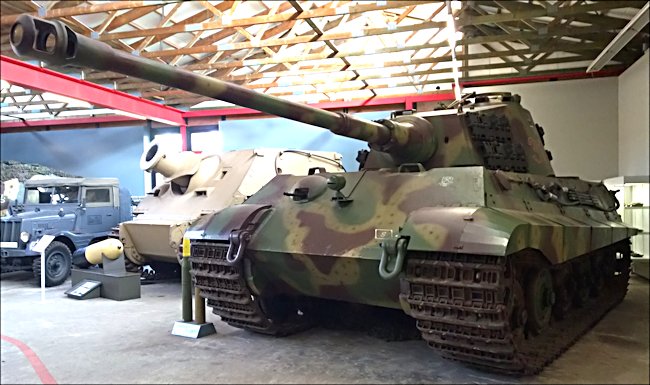
German Königstiger Tank Ausf. B
Specifications
The Panzerkampfwagen VI Ausf. B Tiger, also commonly referred to as the Köningstiger, King Tiger, Royal Tiger or Tiger II tank was armed with a 88 mm (3.46 in) KwK43 L/71, 86 rounds and two or three 7.92 mm (3 in) MG 34 machine guns, 5800 round. Its armour ranged from 25mm to 180mm. It had a crew of five: commander, driver, gunner, loader and radio operator/machine gunner. It was powered by a V12 Maybach HL230 P30 690hp petrol engine. It weighed 69.8 tonnes. It had a top road speed of 35km/h (24mph). It had an operational range of 170 km (110 miles). Total production was 492 tanks.
This tank's history
It has a Fahrgestell production number of 280101, turret number 280110, and belonged to the SS-Pz. Abt. 501, with the tactical number 121 not 321. It was captured in La Capelle, France near Cambrai and the Belgian border, after it had run out of fuel and been abandoned by its crew in September 1944
The crew disabled the gun and engine and left it blocking the road, it was bulldozed off the road in September 1944 and it rolled down the embankment. It landed upside down in the field below. In December 1944 it was recovered by the British REME and was shipped to the US and was send to Aberdeen tor test trials. Later to be shipped back to Germany Koblenz and in December 1960 it went to the tank museum in Munster, Germany, It was restored to running order in 1982 with the assistance of the Wegmann company at Kassel. It is fitted with take mudguards and a muzzle brake and now carries the turret number 321.
Hitler orders the Tiger II B to the Ardennes
Hitler still believed that a well executed Ardennes offensive against the allies could beat them. Thus releasing much-needed troops for the Russian front to at least try and halt the Russian advances. He believed he could force the allies come to peace terms from a stalemate position will stop even Hitler must have known that the Battle of the Bulge would be the last chance for his panzers.
By an impressive scraping together of resources a clever use of logistics, the Germans managed to collect enough equipment, supplies and troops to mount a winter offensive. What was amazing is that the allies did not believe the few pieces of intelligence they received about massive buildup over the Belgian border.
The allies were exhausted having been fighting constantly for six months. It was a very bad winter. It was cold and there was thick snow on the ground. They believe the Germans were nearly beaten. Stories of the massive concentration of firepower and new weapons did not seem logical.
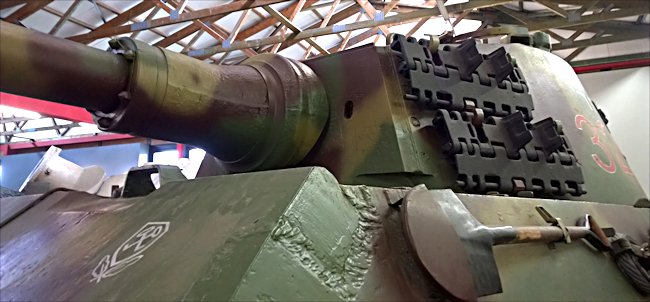
The Royal Tiger Tank's thick frontal armour was dovetailed together and welded for extra strength
Over 250,000 men and 1000 tanks and armoured vehicles had been massed together ready for the orders to attack. This force represented the very last reserves of manpower on the German Western front. If the offensive failed there would be nothing to stop the allies entering Germany.
Hitler's plan was to launch an armoured led thrust just north of Luxembourg heading towards Liege and then on to port of Antwerp. That would split the allies, the Americans would be in the south and the British and Canadians in the north. Antwerp at this stage of the war was the main supply port for the allies. The Germans were counting on capturing those military supplies and utilising them. This would also deny the allies of their supply chain.
The Germans knew from patrols in the Ardennes that the troops there were not elite units. Many had been sent there to rest. The Germans believed the allies would never consider the Ardennes being used as an attack route yet again. The Germans had used it in 1914 and again in 1940. This was exactly why they did use it.
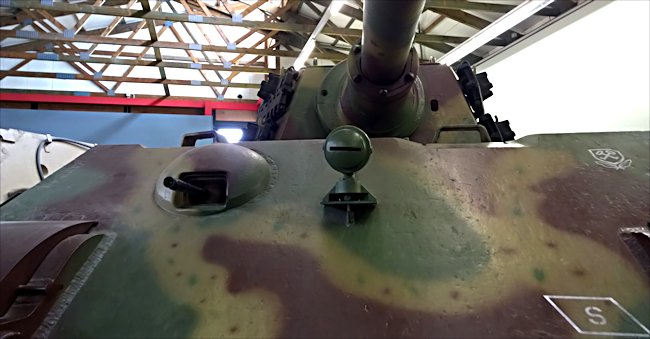
Ball mounted armoured Machine gun and headlight on the Tiger II Ausf. B Heavy Tank
Not all the German generals were happy about being ordered by Hitler to start this offensive. They could see the problems with the plan. The main ones being the lack of supplies, ammunition, fuel scarcity and the defence from air attack, if the weather cleared. At this late stage the war, no general was willing to risk his career or execution, by questioning the Fuhrer's orders.
There was a slim chance of success with the Ardennes offensive but it was very much a gambler. Hitler was relying very much upon surprise, the hope of the winter cloudy skies would prevent the Allied air forces giving their troops support and that they would capture Allied supplies.
The Germans have been busy in developing new tanks and assault gun designs leading up to the winter of 1944. One of the most significant new designs was a Tiger II B tank, more commonly known as the King Tiger or the Royal Tiger tank.
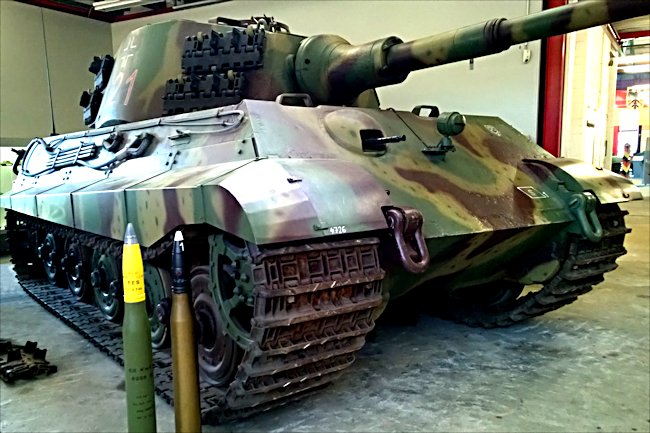
The Königstiger Tank Ausf. B had to have very wide tracks to stop it sinking in the mud.
This new tank weighed 68 tonnes, it had a crew of five, an upgraded high velocity 88mm L71 cannon and 188 mm thick sloping frontal armour. Even though it was incredibly heavy it had a very respectable top speed of 24 mph. The German tank designers had built a tank that could take on the Russian IS-2 heavy tank.
It could easily destroy any tank in the allies arsenal. The design process for this tank started in 1943. The first production vehicles came out of the factories a year later. Around 470 these vehicles have been produced. They were distributed to different battlefields. Only about 70 were used anyone action at the same time.
As World War II progressed, all sides found out that heavier tanks were required, with ever bigger high velocity guns, if it was to survive on the battlefield. Tanks were did not have thick sloping protective armour were easily knocked out.
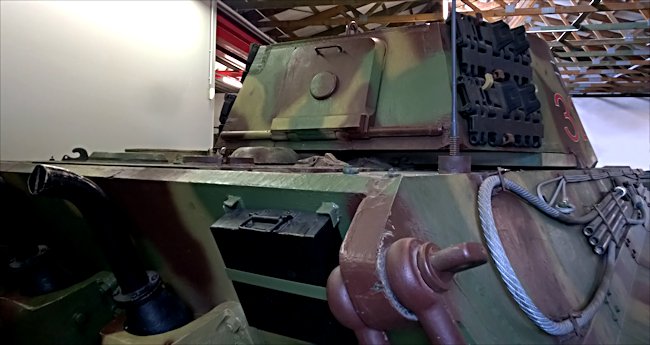
Rear hatch on a Royal Tiger Tank Ausf. B
The first 50 King Tiger tanks made were fitted with the turret made by Porsche. The remaining Tiger II were fitted with a turret made by Henschel. The Porsche turrets were originally made for a Porsche designed Tiger II tank chassis. When this contract was awarded to another company, Porsche had already made 50 turrets. The only surviving example of the Tiger II tank with a Porsche turret can be found at the Bovington Tank Museum.
At 75 tonnes fully loaded German tank design had reached the limits of what the current chassis could handle. It still has a number of features that continued to be used in post war tanks. The design lessons using sloped armour was incorporated in the King Tiger.
The first time that the King Tiger saw action was during the Allied invasion of France in June 1944. Around 15 King Tigers were involved in these battles. A full Battalion of 45 King Tiger tanks were sent to the Arnhem area in September 1944. They help to stop the Allied operation Market Garden offensive was thwarted. Like the Tiger I tank its bigger brother was better suited for operations in open countryside. Many were sent to the Eastern front.
The SS 501st Battalion, which was past of the 6th Panzer Army, with its 45 Royal Tiger tank's, was given orders to participate in the Battle of the Bulge. It was was placed at the front of the advance. They would become this spearhead of the attack.
The problem with the King Tiger was it was too heavy, to wide and cumbersome to negotiate the narrow streets, roads and bridges of the Ardennes. There were a number of problems in getting a Tiger II into action. They were very prone to mechanical break down. They were very thirsty machines. The allies commander the air meant that it was difficult to bring up fuel reserves to the front during daylight hours.
It was lack of fuel, break downs, artillery fire and the arrival of rocket firing RAF and USAF aircraft in the skies over the Ardennes that stopped the King Tiger tanks in January 1944. Not direct fire from other tanks. There is one photograph at the Imperial War Museum that records a knocked out Tiger II in Oosterbeek, Holland. it was finally knocked out by two anti-tank PIAT hand launched infantry rockets. Because the tank was fighting in an urban environment the Allied soldiers had managed to sneak up close to the rear of the King Tiger without being detected and safe from machinegun fire.
The King Tiger was famous to be a tough nut to crack! The veterans was always amazed that the tank could survive continuous artillery barrage and direct HE shots from the Soviet IS-1 or IS-2 although it did created damage especially on the roof of the turret and the engine compartment! But despite claims to the contrary the quality of it's armour and welding always remained high up to the end! In all the photos I've never seen a King Tiger with popped armour and welding! You will find penetrations on the sides but almost never at the front! Spalling does occur and the rear side of the turret was the weak part because of the ammo that was stowed! It had been improved somewhat by installing panels on the side of the ammo but never really solved!
Where can I find other preserved King Tiger Tanks?
- (Porsche turret) – Bovington Tank Museum
- Bovington Tank Museum
- Munster Panzer Museum
- December 44 Museum, La Gleize, Belgium
- Musée des Blindés, Saumur, France
- Schweizerisches Militärmuseum, Full, Switzerland
- Kubinka Tank Museum, Russia
- National Armor and Cavalry Museum, Fort Benning, GA, USA
- Wreck - Fontenay-Saint-Père, France
- Wreck - The Wheatcroft Collection, England
- Source - Pierre-Oliver Buan - http://the.shadock.free.fr/Surviving_Panzers.html
WW2 tank books

